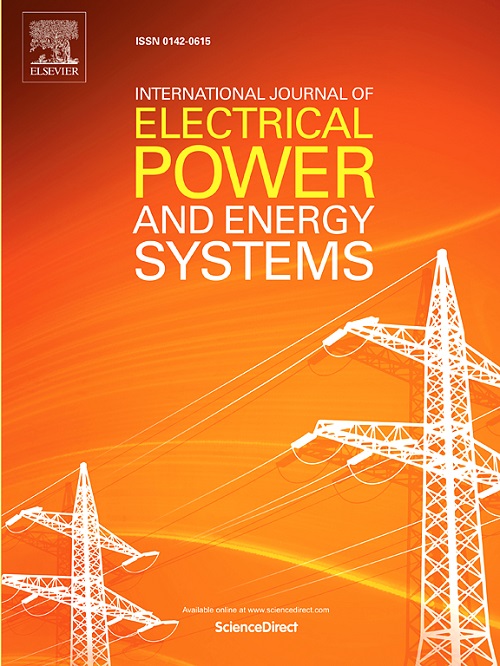基于矩差分析理论的配电网最小光伏弃风
IF 5
2区 工程技术
Q1 ENGINEERING, ELECTRICAL & ELECTRONIC
International Journal of Electrical Power & Energy Systems
Pub Date : 2025-03-31
DOI:10.1016/j.ijepes.2025.110654
引用次数: 0
摘要
分布式光伏(DPV)系统在配电网中的高渗透率会导致一系列问题,如反向潮流和电压违例,对配电网的安全运行构成重大威胁。在现有条件下,实现分布式光伏的最小弃电是保证分布式光伏安全运行和有效利用可再生能源的最直接、最经济的手段之一。引入PV矩和荷载矩的概念,提出了具有DPV的dn的矩差分析理论。该理论将DPV的积分挑战转化为平衡矩差(MD)方程以恢复和维护电力的问题。对于给定的DN,当最高节点电压达到指定的电压限值时,MD(定义为PV矩与负载矩之间的差)近似于称为临界矩差(CMD)的常数。该CMD由DN的拓扑结构和线路参数决定,与负载分布和PV部署无关。理论推导和案例研究证实了这一概念。CMD表示DN集成DPV的容量限制。DPV矩是DN需要容纳的量,而负载矩是容纳PV矩的资源。提出了一种基于MDAT的分布式光伏最小限电方法,并将其应用于国网山东电力公司四川口10 kV馈线和12.66 kV IEEE 33母线、69系统的分析计算。实例研究表明,与传统的粒子群优化方法相比,本文提出的最小光伏弃风策略在误差为0.6%的情况下,优化速度提高了4736.82倍。验证了该方法的正确性和快速性,适用于实时优化和调度,以实现DNs中最小的PV缩减。本文章由计算机程序翻译,如有差异,请以英文原文为准。
Minimum PV curtailment for distribution networks based on moment difference analysis theory
The high penetration of distributed photovoltaic (DPV) systems in distribution networks (DNs) can lead to a series of issues such as reverse power flows and voltage violations, posing a significant threat to the safe operation of DNs. Achieving the minimum curtailment of DPV in DNs is one of the most direct and cost-effective means to ensure their safe operation and effectively utilize renewable energy sources under existing conditions. Introducing the concepts of PV moments and load moments, the moment difference analysis theory (MDAT) for DNs with DPV is proposed. This theory transforms the integration challenge of DPV into a problem of balancing the moment difference (MD) equations for power restoration and maintenance. For a given DN, when the highest node voltage reaches the specified voltage limit, the MD, defined as the difference between PV moments and load moments, approximates a constant known as the critical moment difference (CMD). This CMD is determined by the topological structure and line parameters of the DN, independent of load distribution and PV deployment. The theoretical derivations and case studies confirm this concept. The CMD represents the limit of a DN’s capacity to integrate DPV. The DPV moment is the quantity that the DN needs to accommodate, while the load moment serves as the resource for accommodating the PV moment. Based on MDAT, a method for the minimum curtailment of DPV in DNs is proposed and applied to the analysis and calculations of a 10 kV feeder line at Sichakou of the State Grid Shandong Electric Power Company and the 12.66 kV IEEE 33 bus and 69 systems. The case studies demonstrate that, compared to traditional particle swarm optimization (PSO) methods, the minimum PV curtailment strategy presented in this paper increases optimization speed by 4736.82 times under an error margin of 0.6 %. This validates the correctness and rapidity of the method, making it suitable for real-time optimization and scheduling for minimum PV curtailment in DNs.
求助全文
通过发布文献求助,成功后即可免费获取论文全文。
去求助
来源期刊
CiteScore
12.10
自引率
17.30%
发文量
1022
审稿时长
51 days
期刊介绍:
The journal covers theoretical developments in electrical power and energy systems and their applications. The coverage embraces: generation and network planning; reliability; long and short term operation; expert systems; neural networks; object oriented systems; system control centres; database and information systems; stock and parameter estimation; system security and adequacy; network theory, modelling and computation; small and large system dynamics; dynamic model identification; on-line control including load and switching control; protection; distribution systems; energy economics; impact of non-conventional systems; and man-machine interfaces.
As well as original research papers, the journal publishes short contributions, book reviews and conference reports. All papers are peer-reviewed by at least two referees.

 求助内容:
求助内容: 应助结果提醒方式:
应助结果提醒方式:


